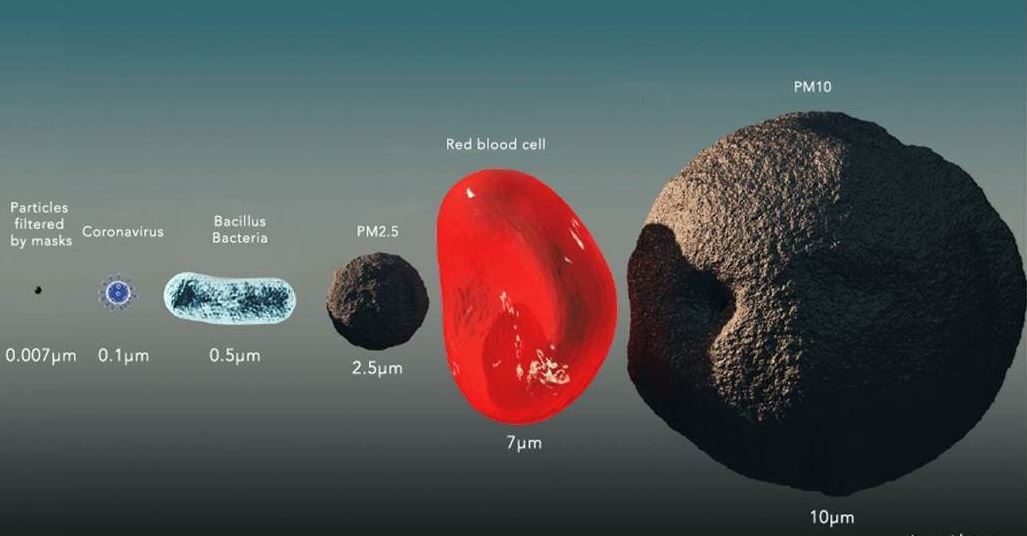Apr 15th 2020
What is Pollution?
- Asbestos
- Biological Pollutants
- Carbon Monoxide (CO)
- Formaldehyde/Pressed Wood Products
- Lead (Pb)
- Nitrogen Dioxide (NO2)
- Pesticides
- Radon (Rn)
- Indoor Particulate Matter
- Secondhand Smoke/Environmental Tobacco Smoke
- Stoves, Heaters, Fireplaces and Chimneys
- Volatile Organic Compounds (VOCs)
- Pet dander and saliva
- Hair, dry skin, and other substances from humans
- Viruses
- Bacteria
- Insect and rodent droppings and body parts
- Rodent urine (dry urine will become airborne)
- Mold
- Mildew
- Ozone
- Nitrogen dioxide
- Carbon monoxide
- Sulphur dioxide
- Particulate matter
- PM10 is matter measuring 10 micrometers or less
- PM2.5 is particles measuring 2.5 micrometers or less
- Reduce lung-function
What is Pollution?
According to the Encyclopedia Britannica, “environmental pollution is the addition of any substance (solid, liquid, or gas) or any form of energy (such as heat, sound, or radioactivity) to the environment at a rate faster than it can be dispersed, diluted, decomposed, recycled or store in some harmless form.” The types of environmental pollution we most commonly discuss, are those related to water, air, and land pollution. However, we also commonly discuss the effects of noise pollution, light pollution, and plastic pollution.

If you are familiar with the Metro Screenworks blog, you may have heard us discuss the effects of indoor air pollution — something we may be less inclined to think about because “being indoors” usually is equated to “being safe.” However, indoor air quality is just as important as the air quality outside the walls of our homes and businesses. Indoor air quality is a growing concern, as many buildings and homes, due to better building practices, are sealed to let less air in — making it better for energy efficiency, but allowing for less air circulation.
How Do We Enjoy Fresh Air Safely
For this reason it is important to open our windows and let fresh outdoor air in. However, what about all the dangerous substances in the air outside? Though outdoor air can provide fresh oxygen due to trees and other vegetation, other harmful substances can make their way inside — what do we do?
Keep reading the latest Metro Screenworks blog to learn more about pollution and how we can still enjoy fresh air within our homes. An example of opening our windows and doors while keeping ourselves, and our families, safe from the pollutants in the air, outside. If you’re looking for high-quality screen products be sure to stop by our online store at MetroScreenworks.com.

The worldwide pandemic of COVID-19 has caused many to think more about what is in the air they breathe. It can be quite unnerving to think about all of what could be in the air of the spaces we frequent, and especially in public spaces. Considering all of this is important; however, it can eventually cause a lot of worry if we dwell on it without the right information. Today, we are going to address air quality and those substances from outside our homes that can threaten it.
What’s In the Air We Breath Inside?
Most of the indoor air pollution we are exposed to can be categorized as chemical, biological, and physical. Common indoor pollutants include:
*** List provided by the EPA.
Though it is important to eliminate the source of the pollution — for example, getting rid of old appliances — in some cases that is impossible. For this reason, cleaning and other hygienic practices are important as well as opening the windows of your home. To learn more about indoor air quality, read our blogs titled, “ Indoor Air Quality & Your Health” and “Indoor Air Quality: What You Thought You Knew,” be sure to check them out.
What’s In the Air We Breathe Outside?
The air quality outside our homes can differ depending on where we live. Typically, those who live in larger cities such as Los Angeles, experience more air quality issues outside their doors than those who live in Salida, Colorado. However, even if you live in a remote area in the mountains, you can still experience outdoor pollution which can make its way inside.
Outdoor Air Pollution
There is a lot that can be floating around in the air outside our homes which we can see . . . trash, seed pods, dust, and hair. However, what about the things we can’t see? Pollution has been an issue for humanity since cities came into existence. The Industrial Revolution during the 19th century accelerated the use of substances and the implementation of processes that create pollution. Thankfully, due to regulations and advances in technology much of those pollutants have been eradicated or significantly reduced. However, there are pollutants that can still threaten us. Common pollutants include:
Particulate Matter
According to the NSW, particulate matter, also called particle pollution or PM describes extremely small solid particles and liquid droplets suspended in the air. Particulate matter is categorized by PM10 and PM2.5

To put that into perspective it’s important to use a method of measurement that we already know: Micron (μm) = Micrometer = 1000 times smaller than a millimeter 1000 microns (μm) = 1 millimeter (mm)
What is Particulate Matter?
The type of particulate matter in the air can differ depending on where you live and other factors. However, most particulate matter found in our air includes:
|
|
|
|
|
|
|
|

Why Does This Matter?
Exposure to these various substances can cause allergic reactions and temporary discomfort, as well as long-term, serious health conditions depending on the substance. Those substances that cause allergies are harmless though our body’s defense system reacts as if they are not. According to WebMD, 1 in 5 Americans have allergies. Those more harmful substances can have both short and long-term consequences:
Short Term Effects
Irritated eyes, nose, and throat |
Asthma and lung diseases (chronic bronchitis, COPD) |
Heart Attacks |
Respiratory complications |
Cardiovascular and respiratory disease |
Increased risk for disease |
Reduced life expectancy |
Arrhythmia's |
Long-Term Effects
Thankfully most of the substances floating around outside won’t cause massive health complications. However, even things that cause allergies can greatly reduce our quality of living.
So, how do we enjoy fresh air and let indoor air pollution out of our homes while keeping outdoor pollutants outside where they belong? Allergy Guard!
Allergy Guard
Allergy Guard is specialty screen mesh designed to keep outdoor pollutants out of your home while still allowing you to enjoy fresh air — which is necessary for good health and keeping coronavirus at bay. This screen mesh is equipped with nanofiber that can filter out coronavirus, bacteria, pollen, fly ash, and other particles that can cause allergies, disease, and even death. Additionally this window screen material provides additional benefits which makes this specialty screen an even more worthwhile investment.

Learn more about Allergy Guard on our last blog post or shop online!

